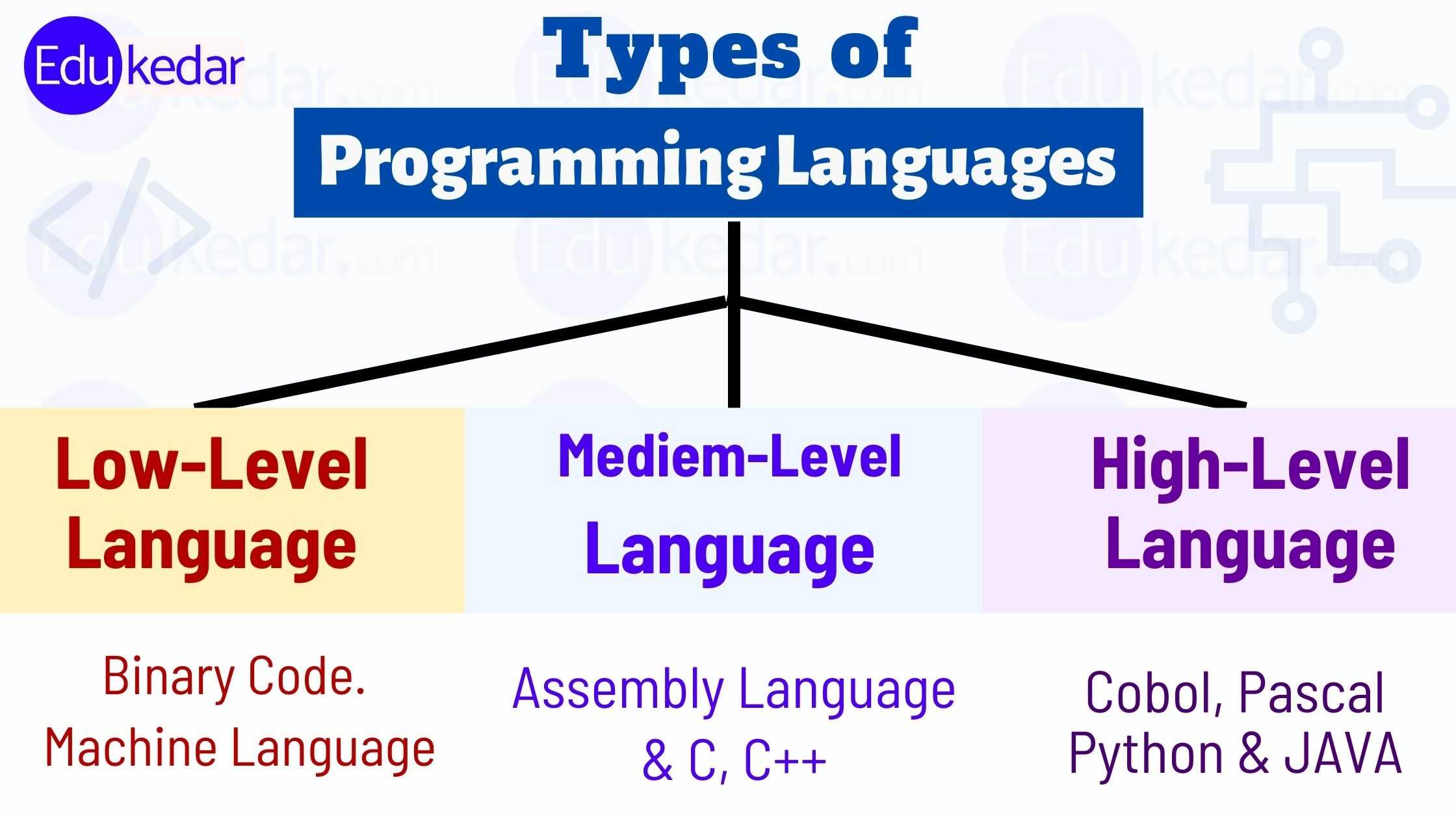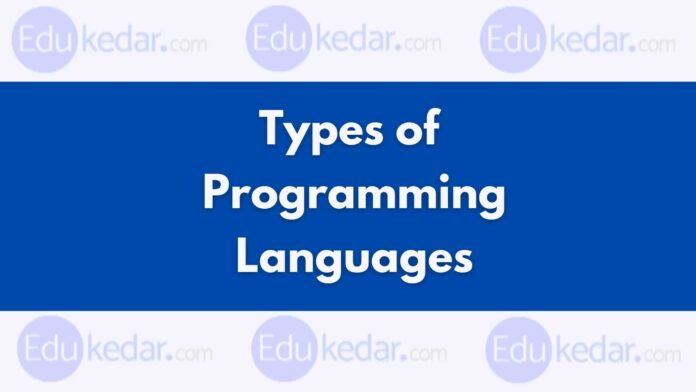Programming language is a collection of instructions that the CPU (Central Processing Unit) assembles to complete a certain task in a computer. Here we have shared types of programming language with examples. This classification is based on the functions and applications of the language.
Each programming language has its own collection of keywords and syntax for constructing a set of instructions. Thousands of programming languages have been created to date, yet each one serves a distinct function.
However, there is no such thing as a programming language category. But to differentiate their function and abstraction we classified the types of programming language based on their level of function.
The level of abstraction provided by these languages from the hardware varies. Some programming languages offer little or no abstraction, whereas others offer more.
► Types of Programming Language:

Programming language can be divided into three categories based on the levels of abstraction:
- Low-level Language
- High-level Language
- Medium Level Language
Machine language provides no abstraction, assembly language provides less abstraction, and high-level language gives a higher amount of abstraction.
Must Read ➜ Types of Memory in Computer
► Low-level Language:
The low-level language is a programming language that provides no abstraction from the hardware and is represented by machine instructions in 0 and 1 forms.
There are two types of Low-level programming language. The Machine level language and Assembly language are two languages that fall into this category.
- Machine level Language
- Assembly level Language
Machine Language
A machine-level language is one that consists of a set of binary instructions that are either 0 or 1. Because computers can only read machine instructions in binary digits, i.e., 0 and 1, the instructions sent to the computer must be in binary codes.
- It is difficult for programmers to write programs in machine instructions, hence creating a program in a machine-level language is a challenging undertaking.
- It is prone to errors because it is difficult to comprehend, and it requires a lot of upkeep.
- Distinct processor architectures require different machine codes;
A machine-level language is not portable since each computer has its own set of machine instructions, therefore a program written on one computer will no longer work on another.
For example, a PowerPC processor has a RISC architecture, which necessitates a different code than an Intel x86 processor with a CISC design.
Assembly Language
Some commands in the assembly language are human-readable, such as move, add, sub, and so on. The challenges we had with machine-level language are mitigated to some extent by using assembly language, which is an expanded form of machine-level language.
- Assembly language instructions are easier to write and understand since they use English words like move, add, and sub.
- We need a translator that transforms assembly language into machine code since computers can only understand machine-level instructions.
- Assemblers are the translators that are utilized to translate the code.
Because the data is stored in computer registers, and the computer must be aware of the varied sets of registers, the assembly language code is not portable.
Because assembly code is higher in the hierarchy than machine code, it is slower. This indicates that assembly code has some abstraction from the hardware, but machine code has none.
Must Read ➜ Recursion function in Python
► High-Level Language:
A high-level language is a programming language that allows a programmer to create programs that are not dependent on the type of computer they are running on.
High-level languages are distinguished from machine-level languages by their resemblance to human languages.
When writing a program in a high-level language, the logic of the problem must be given complete attention.
To convert a high-level language to a low-level language, a compiler is necessary.
Examples of High-Level Programming Language:
- COBOL used for business application
- FORTRAN used for Engineering & Scientific Application
- PASCAL used for General use and as a teaching tool
- C & C++ used for General purposes and it is very popular
- PROLOG used for Artificial intelligence
- JAVA used for General purpose programming
- .NET used for General or web applications
Advantages of High-level language:
- Because it is written in English like words, the high-level language is simple to read, write, and maintain.
- The purpose of high-level languages is to overcome the drawbacks of low-level languages, namely portability.
- The high-level language is machine-independent.
- High-level programming language is portable.
Must Read ➜ What is HTTP?
► Medium Level Language:
Programming languages with features of both Low Level and High-Level programming languages are referred to as “Middle Level” programming languages.
- Medium-level language is also known as the intermediate-level programming language.
- There is no such thing as a programming language category.
- Medium level language is a type of programming language that has features of both low-level and high-level programming languages.
Examples of Medium Level Programming Language:
C, C++, and JAVA programming languages are the best example of Middle-Level Programming languages since they combine low-level and high-level characteristics.
Must Read ➜ What is Multiprocessor?
► Other Types of Programming Language.
There are few other programming languages that are known by their name of generation. A few of them are listed as follows;
- Procedural Languages
- Non-Procedural Languages
Procedural Languages:
Third-generation languages are sometimes known as procedural languages (3GLs). Procedures are used to design a program in a procedural language.
A procedure is a set of instructions with its own name. The procedure’s instructions are carried out using the name as a reference.
The program instructions in procedural programming languages are written in a certain order in which they must be executed to solve a certain problem. It signifies that the sequence in which computer instructions are executed is critical.
Example of Procedural Languages
The following are some examples of popular procedural languages:
FORTRAN is a programming language that can be used to denotes the translation of a formula. It was created for IBM computers in 1957. It was the first high-level programming language to implement the concept of modular programming. It has undergone numerous revisions. FORTRAN 77 is the most widely used version.
COBOL (Common Business Oriented Language) is an acronym for Common Business Oriented Language. It was first created in 1959. This high-level language was created specifically for corporate and commercial use. It was well-suited to dealing with massive amounts of data, such as:
- Payroll preparation
- To process credit and debit card transactions
- To manage inventory and a variety of other business applications
Pascal is a computer language named after Blaise Pascal, a physicist and mathematician who built the first mechanical calculator. In 1971, structured programming language became prominent in the field of computer science. It is appropriate for use in the scientific field.
ADA – it was created in 1980 and was named after Lady Augusta ADA. She was the first person to program a computer. Pascal, a high-level structuring language, served as a basis for the creation of the ADA language. This language is mostly used in Defence applications, such as commanding military weaponry such as missiles.
Dennis Ritchie and Brian Kernighan created the C programming language at Bell Laboratories in 1972. Although it is a high-level language, it may also support assembly language (low-level codes). It’s because the C programming language is also known as a middle-level language.
The C program can be compiled and executed on any type of machine.
- To put it another way, applications built in the C programming language are portable.
- The C programming language is a well-structured programming language.
- The fundamental aspect of the C programming language is that it has a huge number of built-in functions that may be used to do a variety of tasks.
- It is also possible for the user to construct his or her own functions.
Must Read ➜ Applet Life Cycle in JAVA
Non-Procedural is also a type of Programming Language
Fourth-generation programming languages are non-procedural programming languages. The sequence of program instructions is irrelevant in non-procedural programming languages. Only what needs to be done is given priority.
The user/programmer uses a non-procedural language to access data from databases by writing English-like instructions.
These are more user-friendly than procedural languages. These languages give easy-to-use programming tools for creating instructions. The programmers do not need to spend a lot of time coding it.
Example of Non-procedural languages
The following are the most important non-procedural languages and tools:
SQL is a widely used database access language that is designed to read and alter database data. The word query denotes that this language is used to make queries (or inquiries) on database data to execute various operations.
SQL, on the other hand, can be used to create tables, add data, delete data, and update data in database tables, among other things.
The report program generator is abbreviated as RPG. IBM developed this language to generate business reports. RPG is typically used to construct applications for IBM midrange systems, such as the AS/400.
Must Read ➜ Manipulators in C++
OOPs (Another type of Programming Language)
OOPs stands for Object-Oriented Programming Languages. The concept of object-oriented programming was first established in the late 1960s, but it has since become the most prevalent method of software development.
Software is constructed utilizing a collection of interface objects in object-oriented programming.
An object is a program component that consists of a group of modules and a data structure.
- Modules, which are sometimes known as methods, are used to obtain data from an object.
- Object-oriented programming is a modern approach to program design.
- It’s a simple way in which the program is created utilizing objects.
- Once a program’s object has been created, it can be reused in other programs.
Example of OOPs
C++ and Java are the most popular and widely used object-oriented programming (OOPs) languages today.





